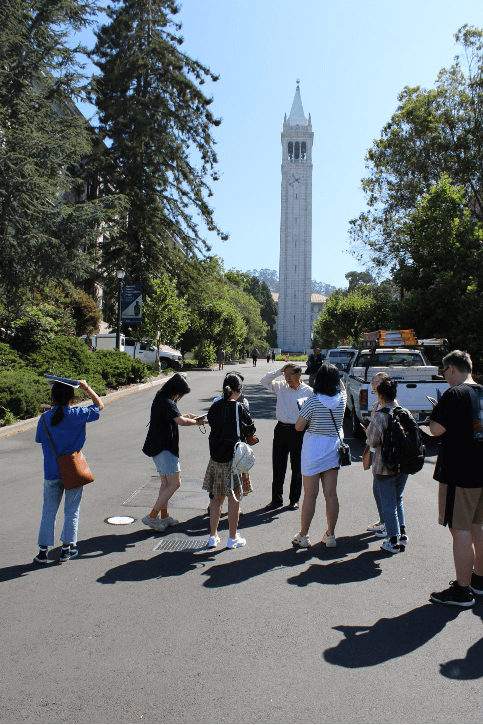Pathway to University of California, Berkeley

Begin Studying at a U.S. Community College and Transfer to a University

Transfer admission guarantee (TAG)
Nothing feels better than getting a guaranteed place at UC. Which is exactly what TAG offers, at any one of six UC campuses. Follow the four steps below and secure your UC TAG.
1. Choosing your campus
Before you apply, figure out where you want to go. Check out our TAG matrix for a full list of the cam- puses in the program, and their individual requirements.
2. Complete your TAG application
Use our Transfer Admission Planner to fill out your TAG application. If you have a community college counselor, review it with them. Don’t worry if you don’t—we have our own UC TAG advisors who can help you out. You’ll need to submit by September 30th for the fall term, or May 31st for the winter/ spring term. Remember, if you miss the TAG deadline, you can still apply to UC during the regular ap- plication period (October 1–November 30).
3. Fulfill all your requirements
Once your application’s submitted, you’ll need to complete all your remaining coursework, and hit the GPA requirements in your TAG agreement.
4. Submit your UC application
When you’re on track for all of the above, fill out the application for admission to UC. Make sure you submit it between October 1–November 30.

Key dates and deadlines
May 1–31: Submit your TAG for winter/spring term
July 1–30: Submit your winter/ spring application for select cam- puses
Oct. 1– Nov. 30: Submit your UC application for undergraduate ad- mission
Sept. 1– 30: Submit your TAG for fall term
5 Benefits of Choosing a Community College to transfer to a Four-Year University
Community Colleges Are More Affordable
According to the Community College Review, the average tuition for full-time, international students is estimated $350 per credit unit. Required 60 to 75 units (Depending on the program.) to transfer to 4 years university. Total cost for estimated tuition will be $11,000 to $14,000 per year of 30 to 35 units.) This is half the average cost of attending a public university as an international student. While this doesn’t cover the cost of fees and books needed, it is a smaller starting figure.
Community Colleges Have Smaller Class Sizes
You may be familiar with the movie troupe of a large lecture hall freshman class. That isn’t so far from the truth for introductory courses at large universities. By comparison, community college classes are generally much smaller. Smaller class size is a benefit for both the students and teachers. Teachers are able to give more individual attention to students and tailor the experience to fit the needs of a smaller group. Students will also be able to get to know their classmates, ask questions during the lesson, and have one-on-one conversations with teachers in a smaller classroom environment.
Less Strict Admission Requirements
Community colleges are great for students who want to earn a degree but might not have a competitive high school GPA for applications. No TOEFL (some colleges required and offer ESL classes) or SAT Score required!
Easier Transition from High School to College
Typically the transition to community college is easier on students leaving high school. With smaller classrooms, flexible schedules, and entry-level courses, students who are concerned about getting lost in a large school might find community college a better fit.
Improved Academic Quality at Community Colleges
In the past, community colleges were looked down on by some, and were not considered a strong academic experience. That has been changing, and while there is still variety in the student experience, community colleges are more widely accepted as a way to knock out gen ed courses before transferring to a four-year program. Community colleges have improved their academic standards to attract more students and meet the transfer requirements of larger universities. This also creates the opportunity for students already attending a four-year university to take summer classes at local community colleges for a lower cost.
Partnership with
- Berkeley City College
- Laney College
- College of Alameda
- Merritt Community College
- Lincoln University
- Patten University
- University of California, Berkeley
- University of California, Davis
- University of California, Irvin
- University of California, Los Angeles
- University of California, Merced
- University of California, Riverside
- University of California, San Diego
- University of California, Santa Barbara
- University of California, Santa Cruz





USEF TAG PROGRAM
United States Education Foundation (USEF) shall provide the following:
Refer international students to Berkeley City College, Patten University or Lincoln University program (Exclude housing and college tuition payment).
A. Basic Program. Program includes:
i. USEF Academic and Career Guidance & Counseling
ii. Academic Enrichment Instruction/Tutoring (Up to10 Hours per week)
iii. Access to USEF Facilities and Staff
iv. Access to USEF Events and Admission Workshops
v. Documentation Repository and Organization (Administrative & University Application)
vi. College Liaison, Administrative Processing, Scheduling, and other college-related services.
B. Individual Program: Program includes:
i. Personalized USEF Academic and Career Guidance & Counseling
ii. Personalized Academic Enrichment Instruction/Tutoring (Minimum 10 Hours per week)
iii.Access to USEF Facilities and Staff & Regularly Scheduled Personalized Meetings
iv.Access to USEF Events and Admission Workshops
v. Documentation Repository and Organization (Administrative & University Application)
vi. UC Application Preparation and Other Services
vii. College Liaison, Administrative Processing, Scheduling, and other college-related services.



